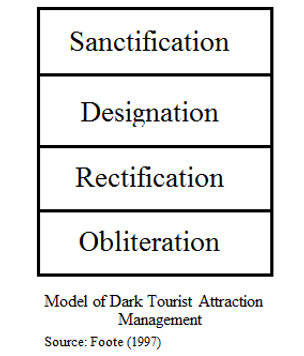
Politics in Dark Tourism
Concepts, Issues and Significances
FREYA EVANS
University of Central Lancashire
TL3067
Dark Tourism and Thana-events
PUNISHMENT
Authenticity
Sharpley & Stone (2009) suggest an alternative concept of states disapproving of their own heritage, the consequences of which can be related back to that of Foote’s (1997) model of Dark tourist Attractions. Though some states such as Cambodia promote the visitation to sites associated with the Genocide, others are willing to disregard history and as a result, disregard responsibility.
Tuol Sleng Prison, Cambodia, is one of the most recognised tourist sites associated to the Cambodian Genocide. A Prison and place of torture, the artefacts found on display are genuine and in the exact condition from when they were left (Sharpley & Stone, 2009). However, Williams (2007) states that the genocide presents a certain blame-culture upon individuals, with recent trials only being issued for a selection of those believed to be involved. Williams (2007) also argues that this political ideology is projected through the museum, where the director of the prison has a personal display of evidence for his crimes. Though the documentations within Tuol Sleng are accurate and therefore authentic to a degree, it is otherwise apparent that political accusations are still present within this matter and as such, deliver influenced material to tourists as a consequence.


The political news of Tuol Sleng
Education is also an issue within the topic of authenticity. Craig & Thompson argue that the educational element of Dark tourism is significant (2012: 180), with Lennon & Foley (2000) supporting this statement that such educational attractions provide an open response for interpretational means. Alternatively, Lennon & Foley (2000) also provide a contrasting case where interpretation is controlled through supply and as such, removes the authenticity from the site. Such an example can be seen in the Latvian Prison, Karosta. Tourists engage in active participation, undertaking the role of the prisoner (Dermody & Brennan, 2014: 129). Similar to the operations of The Dungeons Fanchise, the attraction provides educational information whilst the performance commences. However, it could be argued that the entertainment factor removes the opportunity for visitors to respectfully remember the prisoners. Thus, it is evident that the method of portraying history to tourists may result in some visitors receiving inauthentic experiences as a consequence to dark tourist attractions being controlled.
© 2014 by Freya Evans. Proudly created with Wix.com